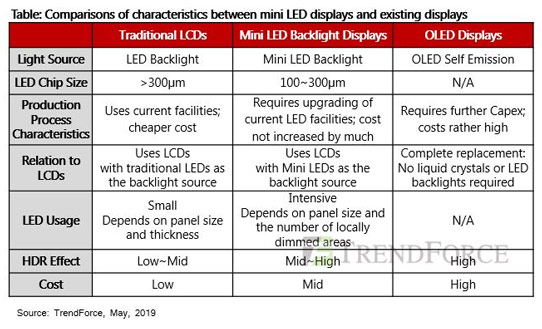- News
20 May 2019
Mini-LED backlit displays to appear in 2019 and challenge OLEDs
After three years of mini-LED backlight technology development, mini-LEDs will finally make an official appearance on displays in 2019 and compete directly with organic light-emitting diodes (OLEDs), according to the ‘2019 Mini LED and HDR High-End Display Market Report’ by LEDinside (a division of TrendForce). With its eyes having been set on the advantages of mini-LED technology for a while, Apple is also eager to strike collaborations with suppliers in Taiwan and Japan to introduce this technology into desktop displays, notebooks and tablets.

Mini-LEDs possess a local dimming function with a contrast effect similar to that of OLED displays. But, on some product lines, costs for mini-LED backlit displays may even be lower than their OLED counterparts, reckons LEDinside. For traditional liquid crystal display (LCD) panel makers, this translates into an opportunity to re-upgrade product specs and a chance to compete with OLED technology.
Costs to become key to backlit mini-LED mass-production feasibility
Since mini-LED backlight technology only differs from traditional ones in its greater usage of mini-LED chips, panel manufacturers only have to redesign driver ICs, select substrates and reinvest in a few items of equipment, such as those used in surface-mounting and equipment inspection. The availability of existing panel production lines for use allows panel manufacturers to undergo a painless, hassle-free upgrade, notes the report.
In contrast, the increased usage of LEDs will certainly raise costs for traditional LCD panels. Finding a way to lower costs and narrow the gap between mini-LED backlit display and traditional LCD costs will be the key to mini-LED backlight prevalence.
From a supply-chain standpoint, Taiwan panel makers are lagging behind in OLED panel production capacity, and are thus the most motivated to develop mini-LED backlight technology solutions. AUO and Innolux worked with their respective LED subsidiaries in development: AUO with Lextar, and Innolux with AOT, Epileds and other companies as main collaborators. Through these partnerships, they hope to maintain the competitive edge that their LCD products previously possessed. Furthermore, Taiwanese LED giant Epistar, which focuses on advanced displays and backlight applications, is providing products custom made for customers and also has the ability to modify its own facilities.
China’s vendors have also been actively developing micro-LED and mini-LED technologies. For example, Sanan has established the first epitaxial wafer and chip production lines for micro-LEDs in first-quarter 2019, and has already finished developing a micro-LED product that uses 20μm chips. Sanan has joined forces with Samsung, becoming Samsung's go-to supplier for mini-LEDs. Chinese panel supplier BOE has also announced that it is forming a joint venture with US-based company Rohinni to produce micro-LED and mini-LED solutions for display backlight sources. Their main aim is to ramp up transfer speed, precision and yield of LEDs to substrates and create cost-competitive products.


